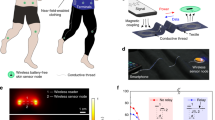Abstract
The design and implementation of a fully integrated transceiver front-end for biomedical data is reported. The system targets the transmission of force data from a distributed sensor system for on-body application. A prototype force transducer patch is presented whose parasitic capacitance is exploited as coupling capacitance for body-channel transmission. The transceiver is implemented in 0.35 μm CMOS technology and occupies an area of 0.0178 mm2. It consumes 360 μA of current at a supply voltage of 3 V. Measured results further confirm a transmission rate of 54 kb/s making the design suitable for use in a distributed pressure sensing network.














Similar content being viewed by others
References
International Organization for Standardization ISO 5982. (2001). Mechanical vibration and shock—Range of idealized values to characterize seated-body biodynamic response under vertical vibration.
Fairley, T. E., & Griffin, M. J. (1989). The apparent mass of the seated human body: vertical vibration. Journal of Sound and Vibration, 22, 81–94.
Holmlund, P., Lundstrom, R., & Lindberg, L. (2000). Mechanical impedance of the human body in vertical direction. Applied Ergonomics, 31, 415–422.
Boileau, P.-E., Wu, X., & Rakheja, S. (1998). Definition of a range of idealized values to characterize seated body biodynamic response under vertical vibration. Journal of Sound and Vibration, 215, 841–862.
Krugman, M. (1996). Instrumented computer keyboard for prevention of injury, US patent 5579238.
Sommerich, C. M., Marras, W. S., & Parnianpour, M. (1996). A quantitative description of typing biomechanics. Journal of Occupational Rehabilitation, 6(1), 33–35.
Kong, K., & Tomizuka, M. (2009). A gait monitoring system based on air pressure sensors embedded in a shoe. IEEE/ASME Transactions on Mechatronics, 14(3), 358–370.
Morris Bamberg, S. J., Benbasat, A. Y., Scarborough, D. M., Krebs, D. E., & Paradiso, J. A. (2008). Gait analysis using a shoe-integrated wireless sensor system. IEEE Transactions on Information Technology in Biomedicine, 12(4), 413–423.
Piezo Film Sensors—Technical Manual. (2006). Measurement Specialties, Inc., P/N 1005663-1 REV D, March 2006.
Zimmerman, T. G. (1996). Personal area networks: near-field intrabody communication. IBM Systems Journal, 35(3&4), 609–617.
Shinagawa, M., Fukumoto, M., Ochiai, K., & Kyuragi, H. (2004). A near-field-sensing transceiver for intrabody communication based on the electrooptic effect. IEEE Transactions on Instrumentation & Measurement, 53(6), 1533–1538.
Cho, N., Yan, L., Bae, J., & Yoo, H.-J. (2009). A 60 kb/s–10 Mb/s adaptive frequency hopping transceiver for interference-resilient body channel communication. IEEE Journal of Solid-State Circuits, 44(3), 708–717.
Hachisuka, K., Takeda, T., Terauchi, Y., Sasaki, K., Hosaka, H., & Itao, K. (2005). Intra-body data transmission for the personal area network. Microsystem Technology, 11, 1020–1027.
Daly, D. C., & Chandrakasan, A. P. (2007). An energy-efficient OOK transceiver for wireless sensor networks. IEEE Journal of Solid-State Circuits, 42(5), 1003–1011.
Bohorquez, J. L., Chandrakasan, A. P., & Dawson, J. L. (2009). A 350 μW CMOS MSK transmitter and 400 μW OOK super-regenerative receiver for medical implant communications. IEEE Journal of Solid-State Circuits, 44(4), 1248–1259.
Quinlan, P., Crowley, P., Chanca, M., Hudson, S., Hunt, B., Mulvaney, K., et al. (2004). A multimode 0.3–200-kb/s transceiver for the 433/868/915-MHz bands in 0.25-_m CMOS. IEEE Journal of Solid-State Circuits, 39(12), 2297–2310.
Thoné, J., Radiom, S., Turgis, D., Carta, R., Gielen, G., & Puers, R. (2009). Design of a 2 Mbps FSK near-field transmitter for wireless capsule endoscopy. Sensors and Actuators A: Physical. doi:10.1016/j.sna.2008.11.027.
Chi, B., Yao, J., Han, S., Xie, X., Li, G., & Wang, Z. (2007). Low power high data rate wireless endoscopy transceiver. Microelectronics Journal, 38, 1070–1081.
Meillere, S., Barthelemy, H., & Martin, M. (2006). 13.56 MHz CMOS transceiver for RFID applications. Analog Integrated Circuits & Signal Processing, 49, 249–256.
Wegmueller, M. S., Kuhn, A., Froehlich, J., Oberle, M., Felber, N., Kuster, N., et al. (2007). An attempt to model the human body as a communication channel. IEEE Transaction on Biomedical Engineering, 54(10), 1851–1857.
Falconer, D. D., Adachi, F., & Gudmundson, B. (1995). Time division multiple access methods for wireless personal communications. IEEE Communications Magazine, 33(1), 50–57.
Peterson, W. W., & Weldon, E. J. (1972). Error-correcting codes (2nd ed.). Cambridge: MIT.
Acknowledgment
This work was supported in parts by the Taiwan Chip Implementation Center (CIC) and National Science Council grant 96-2221-E-110-001-MY2.
Author information
Authors and Affiliations
Corresponding author
Rights and permissions
About this article
Cite this article
Huang, YT., Rieger, R. An OOK Body-Channel Transceiver Front-End ASIC for Distributed Force Measurement. J Sign Process Syst 64, 177–185 (2011). https://doi.org/10.1007/s11265-009-0419-3
Received:
Revised:
Accepted:
Published:
Issue Date:
DOI: https://doi.org/10.1007/s11265-009-0419-3




